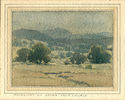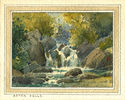
19th, 20th & 21st Century Fine Prints
707-546-7352 · fax 707-546-7924 · web: www.annexgalleries.com · email: artannex@aol.com
Percy Gray Biography
Percy Gray
American
1869–1952
Biography
 Percy Gray was born in San Francisco in 1869 to a family with a rich artistic and literary heritage. Gray's father emigrated from England to Australia, married and moved to San Francisco, where he thrived in the insurance business. Percy grew up in the young city, which harbored ambitions to become a major cultural center. During a childhood illness, he discovered a talent for art. He attended the California School of Design from 1886 - 1888 and began a career as a newspaper illustrator, ending up with a job at the New York Journal in 1895. Gray spent the next eleven years as a newspaper artist in New York City but also found time to study at the Art Students League and with William Merritt Chase. As a newspaper illustrator, Gray learned how to get the facts of a scene clown quickly and correctly. In 1906, Gray was dispatched to San Francisco to cover the catastrophe caused by the earthquake and fire that occurred in April of that year. He then remained in the city of his youth, and launched into a career as an exhibiting artist.
Percy Gray was born in San Francisco in 1869 to a family with a rich artistic and literary heritage. Gray's father emigrated from England to Australia, married and moved to San Francisco, where he thrived in the insurance business. Percy grew up in the young city, which harbored ambitions to become a major cultural center. During a childhood illness, he discovered a talent for art. He attended the California School of Design from 1886 - 1888 and began a career as a newspaper illustrator, ending up with a job at the New York Journal in 1895. Gray spent the next eleven years as a newspaper artist in New York City but also found time to study at the Art Students League and with William Merritt Chase. As a newspaper illustrator, Gray learned how to get the facts of a scene clown quickly and correctly. In 1906, Gray was dispatched to San Francisco to cover the catastrophe caused by the earthquake and fire that occurred in April of that year. He then remained in the city of his youth, and launched into a career as an exhibiting artist.
Gray's first paintings, exhibited in 1907, depicted stretches of ocean with waves breaking against headlands. Gray soon began to explore other subjects, including landscapes with eucalyptus trees swaying in the fog, their indistinct outlines full of ghostly suggestiveness.
Although Gray often painted bright works in the impressionist mode, his primary inspiration was directed towards muted landscapes in the style now known as "tonalism." The emotions most typically expressed in his pictures were those of quiet, introspective pleasure, rather than sublimity or joy. Gray's work became popular, and his paintings, exhibited at various San Francisco galleries, were sought after. In 1915, his watercolor, Out of the Desert, Oregon, won a bronze medal at the Panama Pacific International Exposition. For most of the time between 1912 and 1923, Gray lived in Burlingame while maintaining a studio in San Francisco.
To the surprise of some of his friends, in 1923, at age 53, the "avowed bachelor" married and moved into the historic Bonifacio adobe in Monterey. Some of Gray's best paintings from his Monterey years celebrate the fortitude of coastal cypress trees in their struggle to survive the constant battering of the elements symbolic of the struggles of human life. In 1939, the Grays sold their Monterey home and returned to San Francisco. In 1941, they settled in the quiet village of San Anselmo in Marin County, about fifteen miles north of San Francisco near the base of Mount Tamalpais. Gray was in his seventies but continued to paint with considerable virtuosity. After his wife died in 1951, he moved back to San Francisco and set up a studio where he died of a heart attack while at his easel on October 10, 1952.
Source: www.tfaoi.com; by Alfred C. Harrison, Jr.
